New Faces for Old Roofs - Page 4
Today’s best bets for flat roofs
The ideal time to install a new cool roof is when your current roof needs replacing, not before. According to Remodeling magazine’s 2014 Cost vs. Value Report, which compares average costs of remodeling projects with the average value those projects retain at resale, you’ll recoup between 84 to 96 percent of your investment in a new roof.
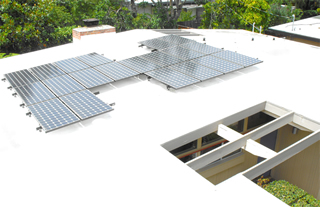 |
|
|
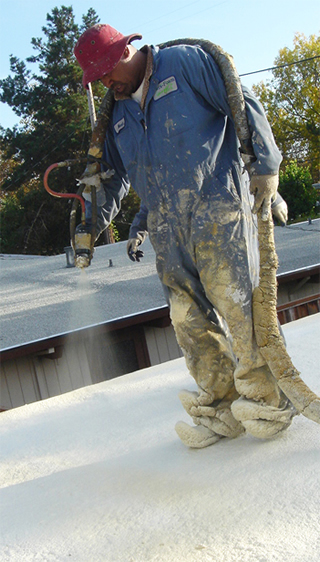 |
|
|
No one ever wants to buy a new roof, but if you’re one of those who needs to get that job done, here’s a guide to the three most common roofing systems used today on residential low-slope and flat roofs. Keep in mind, your system of choice is only as good as the installer who lays it down. So do your homework.
Polyurethane foam
Foam roofs, made with polyurethane foam that is sprayed on, have long been a popular choice among Eichler owners because the material is lightweight, durable, and seamless. The foam adheres smoothly around roof penetrations such as skylights, pipes, and vents to form an impenetrable surface that is durable and rigid enough to walk upon. The insulation qualities of foam help to keep inside temperatures consistent year-round.
Randy Feriante, owner of Dura-Foam Roofing in Menlo Park, says customers usually see their energy bills drop about 30 percent after installing an insulating foam roof, which includes a cool-roof elastomeric coating.
“This coating very effectively reflects the sun's energy from the roof surface,” Feriante says. “White is the most common color, but other colors can be used when roof surfaces are more visible from the perspective of neighboring properties.”
Sprayed polyurethane foam is a reliable roofing material because it does not absorb water and seamlessly adheres to all surfaces to form a watertight seal. On typical projects, a 1.5-inch layer of polyurethane foam provides the primary waterproofing barrier.
These roofs can last 30 years or more, says Feriante, and range in cost from $11,000 (for a small Eichler) up to $25,000. A single follow-up elastomeric re-coat is recommended by most installers after five to ten years.
Single-ply
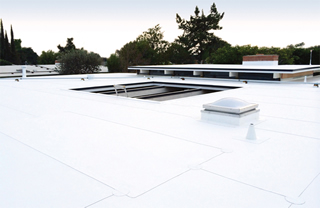 |
|
|
Single-ply roofs are made from factory-manufactured sheet membranes. They generally are categorized as either thermoplastic or thermoset. Thermoplastic materials can be repeatedly softened when heated and hardened when cooled. Thermoset materials solidify, or ‘set,’ irreversibly after heating. Single-ply sheet membranes can contain reinforcement layers such as polyester fabrics or scrims, glass fiber, or a felt or fleece backing.
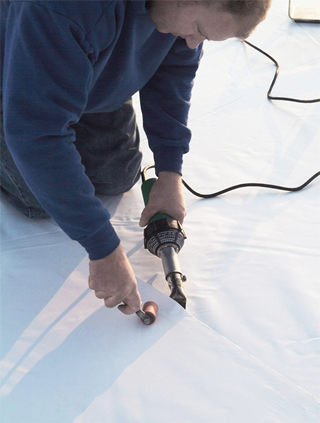 |
|
|
|
|
“Systems like our IB Roof product are lightweight and ideal for the post-and-beam structures of an Eichler home,” says Trevor Leeds, president of Chandler’s Roofing in San Pedro. “They require very little maintenance and offer edge-to-edge warranties on the system.”
Single-ply membranes can be installed fully adhered, mechanically attached, or held down with ballast. In many instances, a combination of attachment methods are used to secure a roof system. For example, insulation may be mechanically attached to the substrate while the roof membrane is fully adhered to the insulation.
For added R-value, single-ply roofs can be installed with rigid foam insulation, which helps to keep the ambient temperature of the home more consistent throughout the year. Available in thicknesses from one to three inches, rigid insulation will add approximately 20 percent to the cost of the job.
Popular single-ply systems among owners of flat and low-sloped roofs include Duro-Last, IB Roof, and Johns Manville, and the prices can range from mid-teens to $30,000, depending on the brand, square footage covered, added insulation, and warranty. The life expectancy of a single-ply system ranges from 20 to 30+ years.
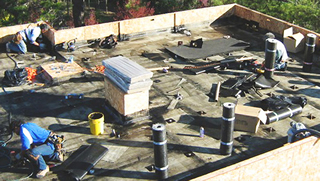 |
Modified bitumen
 |
|
|
Modified bitumen roofing systems were first used in the United States in the 1970s. Manufactured in a rolled material, modified bitumen membranes contain polymer-modified bitumen (another word for asphalt) with reinforcing modifiers of fiberglass, polyester, or a combination of the two materials, giving it more rubber- or plastic-like qualities.
Modifiers help to provide tensile strength and flexibility to the roof, qualities that help the roof withstand a building's flexing and moving.
“Modified bitumen is very tough and versatile, and it’s lightweight and is easy to maintain,” says bitumen installer Fred Worrell of Worrell Roofing in Palo Alto.
Modified bitumen can be installed as one-, two-, or three-ply systems, though most are two-ply applications. The system is generally composed of a base sheet, plus two modified ply layers. Each layer is attached to one another and sealed using heated asphalt. The roof is then topped with a surfacing material, such as a reflective granulated surface that reflects ultra-violet rays.
“It’s available with a built-in cool-roof coating, or the membrane can be coated to meet cool-roof standards,” says Worrell.
A modified bitumen roof system can last beyond 20 years, depending on the quality of the materials and the contractor installing it. “I have many systems still doing fine at the 25-year mark,” says Worrell.
Torch-applied bitumen systems on average, says Worrell, cost between $800 and $1,000 per 100 square feet.
- « first
- ‹ previous
- 1
- 2
- 3
- 4




